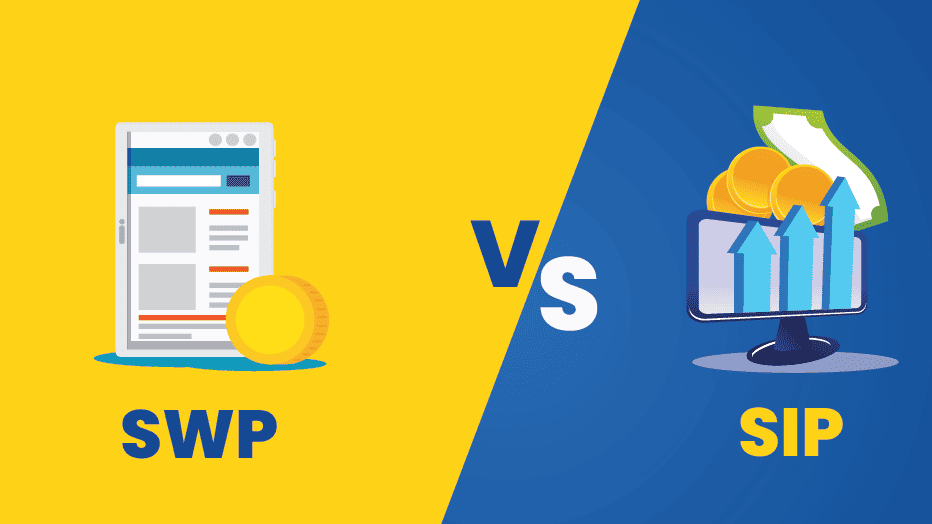Purpose and Concept:
SIP (Systematic Investment Plan)
- Purpose: SIP involves investing a fixed amount regularly (typically monthly) in mutual funds over a long period.
- Concept: By investing regularly, investors benefit from rupee cost averaging (buying more units when prices are low and fewer units when prices are high) and the power of compounding over time. SIPs are often used for long-term wealth accumulation and achieving financial goals like retirement planning or education funding.
SWP (Systematic Withdrawal Plan)
- Purpose: SWP involves withdrawing a fixed amount regularly from mutual fund investments.
- Concept: It provides a way for investors to create a steady income stream from their mutual fund investments. Instead of withdrawing a lump sum, investors can set up an SWP to receive periodic payouts, which can be monthly, quarterly, or annually. SWPs are often used by retirees or those seeking regular income from their investments while keeping the principal amount invested.
Investment Objective:
SIP (Systematic Investment Plan)
Objective: SIP is typically used for long-term wealth creation and achieving financial goals over time.
Specific Uses:
- Long-term Wealth Creation: SIPs allow investors to accumulate wealth steadily over the years through disciplined and regular investments in mutual funds.
- Retirement Planning: Many investors use SIPs as a strategy to build a retirement corpus, benefiting from compounding returns over a long investment horizon.
- Achieving Financial Goals: Whether it’s saving for a child’s education, buying a house, or any other financial goal, SIPs help investors accumulate funds systematically.
SWP (Systematic Withdrawal Plan)
Objective: SWP is primarily used for generating regular income from investments.
Specific Uses:
- Retirement Income: SWPs are often employed by retirees to create a steady income stream from their accumulated mutual fund investments.
- Regular Cash Flow: Investors may use SWPs when they need a consistent flow of funds for living expenses or other financial obligations.
- Managing Surplus: SWPs can also be used to systematically withdraw excess funds that have accumulated in mutual funds over time.
Frequency and Amount:
SIP (Systematic Investment Plan)
- Frequency: Investors can choose the frequency of investments, typically monthly, quarterly, or annually. This frequency remains consistent throughout the SIP tenure.
- Amount: Investors determine a fixed amount to invest regularly at each interval. This amount can vary based on their financial capacity, goals, and risk tolerance. Adjustments can be made over time to increase or decrease the investment amount as needed.
For example, an investor might set up a monthly SIP of ₹10,000 in a mutual fund scheme.
SWP (Systematic Withdrawal Plan)
- Frequency: Investors decide how frequently they want to withdraw funds, which can be monthly, quarterly, semi-annually, or annually.
- Amount: Investors specify a fixed amount they wish to withdraw at each interval. The withdrawal amount can include gains, dividends, or a portion of the principal amount invested, depending on the investor’s preference and financial needs.
For instance, an investor might set up a quarterly SWP of ₹25,000 from their mutual fund investment.
Risk and Returns:
SIP (Systematic Investment Plan)
- Risk Management: SIP helps in managing market volatility through a strategy known as rupee cost averaging. Since investments are made at regular intervals, more units are purchased when prices are low and fewer units when prices are high. This averages out the cost per unit over time, potentially reducing the impact of market fluctuations.
- Returns: Over the long term, SIP aims to benefit from the power of compounding and market growth. By consistently investing regardless of market conditions, SIP investors can potentially achieve higher returns over time as markets tend to trend upwards in the long run.
SWP (Systematic Withdrawal Plan)
- Risk Considerations: The primary risk with SWP is the potential erosion of the principal amount if the withdrawals exceed the returns generated by the investments, especially during market downturns. This could reduce the overall value of the investment over time if not managed carefully.
- Returns: SWP returns are influenced by the performance of the underlying mutual fund investments and market conditions. If the fund performs well and generates returns that exceed the withdrawal amount, investors can sustain their income stream over the desired period. However, poor market performance may impact the ability to maintain the same level of withdrawals without reducing the principal.
Tax Implications:
SIP (Systematic Investment Plan)
Taxation on Capital Gains: SIP investments in mutual funds are subject to capital gains tax. The taxation depends on the holding period of the mutual fund units:
- Short-term Capital Gains: If units are sold within 3 years of purchase, gains are treated as short-term capital gains (STCG) and taxed according to the investor’s income tax slab rates.
- Long-term Capital Gains: If units are held for more than 3 years, gains are treated as long-term capital gains (LTCG). As of current regulations (subject to changes), LTCG exceeding ₹1 lakh in a financial year are taxed at 10% without the benefit of indexation.
Taxation on Dividends: Dividends received from mutual funds are tax-free in the hands of the investor. However, a dividend distribution tax (DDT) is deducted by the mutual fund before distributing dividends to investors.
SWP (Systematic Withdrawal Plan)
Taxation on Withdrawals: The tax implications of SWP depend on the nature of the withdrawal:
Withdrawals from Gains: If the withdrawal amount includes gains realized on the mutual fund units, it is subject to capital gains tax.
- Short-term Capital Gains: Taxed at applicable income tax slab rates if units are held for 3 years or less.
- Long-term Capital Gains: Taxed at 10% without indexation if units are held for more than 3 years and gains exceed ₹1 lakh in a financial year.
Withdrawals from Dividends: If the withdrawal amount includes dividends received from the mutual fund, dividends are tax-free in the hands of the investor. However, mutual funds deduct DDT before distributing dividends.
Flexibility and Control:
SIP (Systematic Investment Plan)
- Flexibility in Investment Amounts: Investors have the flexibility to adjust the amount they invest regularly. They can increase or decrease the SIP amount based on their financial situation, goals, and risk tolerance.
- Flexibility in Investment Frequencies: SIPs can be set up with different frequencies such as monthly, quarterly, or annually. Investors can choose the interval that best suits their cash flow and investment strategy.
- Flexibility in Fund Choices: Investors can select different mutual fund schemes or switch between funds based on their investment objectives and market conditions. This allows for diversification and adaptation to changing investment preferences.
SWP (Systematic Withdrawal Plan)
- Flexibility in Withdrawal Amounts: Investors can adjust the amount withdrawn periodically based on their income needs. Whether they need a fixed amount each month, quarter, or annually, SWP allows for customization to match cash flow requirements.
- Flexibility in Withdrawal Frequencies: SWP can be set up to withdraw funds at different intervals like monthly, quarterly, semi-annually, or annually. This flexibility helps in aligning income withdrawals with specific financial needs or goals.
- Adaptability to Changing Needs: SWP offers the flexibility to modify withdrawal amounts or frequencies over time. Investors can increase or decrease withdrawals as per changing income requirements, unexpected expenses, or other financial circumstances.
Suitability:
SIP (Systematic Investment Plan)
Suitability: SIP is well-suited for individuals who aim to build wealth steadily over the long term.
Ideal Candidates:
- Long-term Financial Goals: SIP is ideal for individuals looking to achieve long-term financial goals such as retirement planning, funding children’s education, or purchasing a home.
- Risk Tolerance: Investors with a moderate to high risk tolerance can benefit from SIPs, as they can withstand market fluctuations over the long term and benefit from rupee cost averaging.
- Wealth Accumulation: SIP helps in accumulating wealth systematically by investing fixed amounts regularly in mutual funds, leveraging the power of compounding over time.
SWP (Systematic Withdrawal Plan)
Suitability: SWP is suitable for retirees or individuals seeking regular income from their investments while preserving their capital.
Ideal Candidates:
- Retirement Income: SWP is particularly suitable for retirees who require a regular stream of income from their accumulated savings and investments.
- Steady Cash Flow: It’s beneficial for individuals who need a consistent cash flow to meet living expenses, without relying solely on fixed deposits or other sources.
- Capital Preservation: SWP allows for systematic withdrawals while aiming to preserve the principal investment amount, making it suitable for those concerned about maintaining their capital base over the long term.
Conclusion
In essence, SIPs and SWPs are complementary strategies that cater to distinct financial goals—accumulation of wealth and generation of income, respectively. Understanding their benefits, suitability, and integration potential can empower investors to effectively manage their investments throughout their financial journey.
FAQs
Q. What is a Systematic Investment Plan (SIP)?
- SIP is a disciplined approach to investing in mutual funds where investors contribute a fixed amount at regular intervals (e.g., monthly, quarterly). It aims to accumulate wealth over the long term through rupee cost averaging and compounding.
Q. What are the benefits of SIP?
SIP offers several benefits:
- Rupee Cost Averaging: Helps in averaging out the purchase cost of units over time, reducing the impact of market volatility.
- Compounding: Allows investments to grow over time, generating potentially higher returns.
- Discipline and Regularity: Encourages disciplined investing habits by automating investments.
Q. Who should opt for SIP?
- SIP is suitable for individuals with long-term financial goals such as retirement planning, children’s education, or wealth creation. It’s ideal for investors who can stay invested for an extended period to benefit from compounding and market growth.
Q. What is a Systematic Withdrawal Plan (SWP)?
- SWP is a strategy where investors withdraw a fixed amount regularly from their mutual fund investments. It is designed to provide a steady income stream while potentially preserving the invested capital.
Q. What are the benefits of SWP?
SWP offers several advantages:
- Regular Income: Provides a structured way to receive periodic payments from mutual fund investments, suitable for retirees or individuals needing regular cash flow.
- Capital Preservation: Aims to maintain the principal investment while generating income.
- Flexibility: Allows adjustments in withdrawal amounts and frequencies to meet changing income needs.
Q. Who should opt for SWP?
- SWP is suitable for retirees or individuals seeking regular income from their investments without liquidating the entire corpus. It’s beneficial for managing cash flow needs while potentially minimizing tax implications.
Q. Can SIP and SWP be used together?
Yes, SIP and SWP can complement each other in financial planning:
- Accumulation Phase: SIP can be used to accumulate wealth over time.
- Distribution Phase: SWP can be used to systematically withdraw funds during retirement or to meet other income needs.
Q. What are the tax implications of SIP and SWP?
- SIP: Taxation applies to capital gains based on the holding period of mutual fund units and dividends received, subject to applicable tax rates.
- SWP: Taxes may apply on gains realized during withdrawals, depending on the nature of the withdrawal (gains, dividends, or principal). Long-term and short-term capital gains tax rates are applicable.
Q. How can I start SIP or SWP?
To start SIP or SWP, you typically need to:
- Choose a suitable mutual fund scheme based on your financial goals and risk tolerance.
- Complete the necessary documentation with the mutual fund provider or through a registered distributor.
- Set up instructions for regular investments (SIP) or withdrawals (SWP) according to your preferred frequency and amount.
Q. What factors should I consider before choosing SIP or SWP? –
Before choosing between SIP and SWP, consider: –
- Your financial goals and time horizon.
- Risk tolerance and investment preferences.
- Income needs and cash flow requirements.
- Market conditions and tax implications.
- The potential for growth and capital preservation.

Owner of Paisewaise
I’m a friendly finance expert who helps people manage money wisely. I explain budgeting, earning, and investing in a clear, easy-to-understand way.


Your blog is my go-to place for educational and insightful posts.